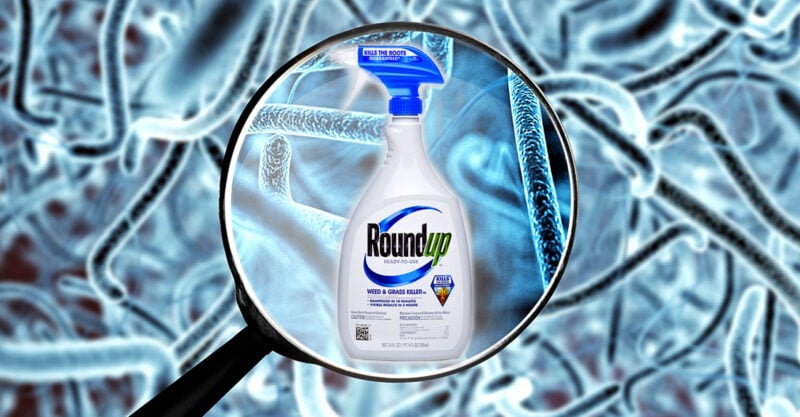Even at ‘Safe’ Levels, Glyphosate Disrupts Immune Function, New Study Suggests
Investigators at the University of Iowa found that at levels approximating the U.S. Acceptable Daily Intake — 1.75 milligrams per kilogram of body weight per day — glyphosate altered the gut microbiome composition and induced “a pro-inflammatory environment.”
Miss a day, miss a lot. Subscribe to The Defender's Top News of the Day. It's free.
A new University of Iowa study provides the first experimental evidence that exposure to glyphosate, even at officially designated “safe” levels, disrupts the gut microbiome in mammals.
Glyphosate is the active ingredient in Monsanto’s (owned by Bayer) widely used line of broad-spectrum herbicides.
Consisting of trillions of benign, ever-resident microorganisms (bacteria, yeast, fungi, and even viruses), the gut microbiome helps animals digest food, fight infections, produce vitamin K and other important biomolecules, and metabolize medicines.
Intestinal microbes, especially certain bacterial species, may also benefit the immune system and heart health while reducing cancer risk and positively affecting healthy aging and longevity. The term “microbiome” refers to these organisms and also to their collective genomes.
Investigators at the University of Iowa found that at levels approximating the U.S. Acceptable Daily Intake (ADI) — 1.75 milligrams per kilogram of body weight per day — glyphosate altered the gut microbiome composition and induced “a pro-inflammatory environment.”
They determined this by measuring the loss of beneficial Lactobacillus and Bifidobacterium bacterial species, and the simultaneous blocking of microbial gene pathways that produce anti-inflammatory short-chain fatty acids.
Changes in gut microbe populations were also accompanied by higher levels of pro-inflammatory markers such as Lipocalin-2 and CD4/IL17A-positive immune system cells, and an increase in fecal pH.
Lipocalin-2 is a biomarker for various forms of kidney diseases, heart failure and obesity-related illnesses. The IL-17 family of cytokines promotes protective immunity against many pathogens but also, paradoxically, drives inflammatory pathology during infection and autoimmunity.
According to the authors of the study, published in the June issue of Environmental Toxicology and Pharmacology, a rising fecal pH inhibits the normal production of anti-inflammatory short-chain fatty acids.
They concluded:
“Collectively, our results suggest that low-dose glyphosate exposure approximating the U.S. ADI is sufficient to modulate gut homeostasis.
“This study also provides new insights into the mechanisms through which glyphosate affects host physiology.”
The state of the microbiome is increasingly viewed as a surrogate marker for an organism’s overall health.
According to the Cleveland Clinic, symptoms of gut microbiome dysregulation include constipation, diarrhea, bloating, fatigue and acid reflux associated with such health conditions as diabetes, obesity, inflammatory bowel disease and irritable bowel syndrome.
First study to link dosage to glyphosate’s effect on gut microbiome
As is often the case with broad-spectrum poisons, glyphosate may affect human health through a variety of mechanisms — few, if any of which have been studied rigorously.
One possible mechanism is disruption of the gut microbiome, which is known to be harmful.
The Iowa study is the first to link dosage, in a systematic way, to glyphosate’s effect on the gut microbiome.
Researchers used C57BL/6J mice, a strain normally selected for studying age-related hearing loss. The animals were reared according to protocol on irradiated feed and moved from one cage to another before testing to normalize each animal’s gut microflora.
The mice were then exposed to three different concentration levels of glyphosate in their drinking water: 1, 10 and 100 micrograms of glyphosate per milliliter of water. The middle dosing scheme, 10 micrograms per milliliter, corresponded to the U.S. adult ADI of 1.75 mg/kg/day (assuming water intake of 4 milliliters per day).
During the 90-day study, researchers collected feces on days 30, 60 and 90, which they froze for future analysis. Similarly, they collected blood on days 30 and 60.
On day 90, investigators dispatched the mice and collected colon tissue for examination of the lamina propria, a rich source of both somatic and immune system cells.
Investigators found glyphosate exposure at doses approximating the U.S. ADI altered the populations of microorganisms normally inhabiting the gut and affected the animals’ neuro-immune-endocrine system toward a pro-inflammatory state.
Even at ADI levels, glyphosate exposure adversely affects the animals’ “gut homeostasis” and physiology, the authors said.
This study begs questions about the test animals’ susceptibility to microbiome dysregulation as a result of rearing, diet, genes or a combination of those factors.
The study’s lead author, Ashutosh K. Mangalam, Ph.D., associate professor and director of the Microbiome Core research facility at the University of Iowa, declined to answer The Defender’s questions on these issues.
Study’s methodology raises questions
It’s been known since at least 2012 that glyphosate interacts with the gut microbiome based on observations of species ranging from honeybees to carp.
Similarly, the herbicide has been known to interfere with immune function for at least a decade.
While all this is established science, demonstrated time and again across species and habitats, it does not in itself mean that glyphosate at the human ADI is harmful to humans.
One should also be wary of extrapolating too readily from what are essentially animal biomarker studies to human health outcomes.
The “further research” called for by the study authors should therefore include validation of their mouse model, followed by challenges to affected animals to study how specific health outcomes correlate to the microbiome alterations under study.
For example, mice could be exposed to pathogens or antigens after microflora alterations to observe inflammatory responses or their ability to fight infectious diseases.
Because of potentially interconnected causation, one of the controls for such an experiment should be animals whose gut bacteria were similarly affected, but by means of a different agent.
In other words, are animals getting sick because of those specific immune cell- or fatty acid-related malfunctions? Or is glyphosate adversely affecting the animal’s health through a different mechanism in addition to its effects on the microbiota?
How big is the glyphosate problem?
The ever-rising year-over-year use of glyphosate in the U.S. goes back decades, despite unrelenting medical and scientific scrutiny.
First approved in 1974, glyphosate is still widely applied in agricultural, government and consumer settings — despite being linked to dozens of serious health issues and, as of 2022, being the target of at least 125,000 lawsuits.
The use of glyphosate-based herbicides jumped tenfold with the introduction of genetically modified “Roundup-resistant” crops. It is the most-used herbicide in U.S. agriculture, with an estimated 287 million pounds applied to fields and crops in 2016.
Despite a barrage of evidence that glyphosate causes harm and huge settlements in favor of plaintiffs, the U.S. Environmental Protection Agency (EPA) historically has granted the chemical and its manufacturer the benefit of the doubt.
Every 15 years, the EPA reviews key aspects of an herbicide’s (“pesticide” in EPA terminology) registration.
In 2020, in response to public comments questioning the chemical’s safety in animals and the environment, the agency reaffirmed its long-held position that the herbicide does not cause human cancer and that there are “no risks of concern to human health from current uses of glyphosate” either to “children or adults” when the product is “used according to label directions.”
Additionally, the agency saw:
- No indication children are more sensitive to glyphosate from “in-utero or post-natal exposure” and there were “no risks of concern from ingesting food with glyphosate residues” or to “children entering or playing on residential areas treated with glyphosate.
- No evidence glyphosate causes human cancers in humans. On this point, the EPA disagrees with the International Agency for Research on Cancer, which in 2015, designated glyphosate a “probably carcinogenic to humans.”
- No indication glyphosate is an endocrine disruptor by virtue of having passed Tier I screening under its Endocrine Disruptor Screening Program.
Similarly and predictably, the National Pesticide Information Center, an EPA-associated group at Oregon State University, denies any connection between glyphosate and human illness:
“Pure glyphosate is low in toxicity, but products usually contain other ingredients that help the glyphosate get into the plants. The other ingredients in the product can make the product more toxic.”
In other words, glyphosate is only toxic if it gets inside plants, which provides little comfort considering its concentrations in human tissues. With either glyphosate or its metabolite present in the urine of 81% of Americans over the age of 6 and in samples from 75% of pregnant Canadian women, the chemical is already inside almost all of us.
The views and opinions expressed in this article are those of the authors and do not necessarily reflect the views of Children's Health Defense.
Sign up for free news and updates from Children’s Health Defense. CHD focuses on legal strategies to defend the health of our children and obtain justice for those injured. We can't do it without your support

